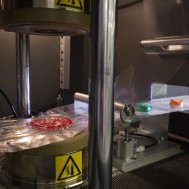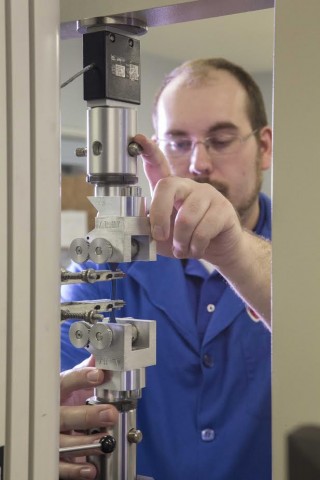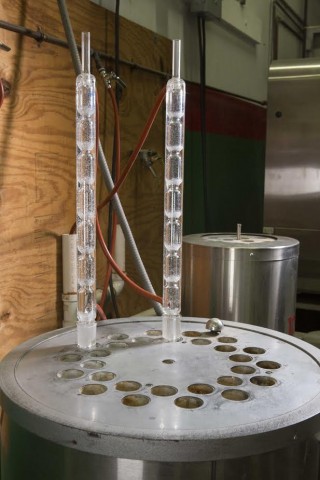We don’t just bounce our rubber products out to the market — our team of engineers are constantly testing, tweaking, and perfecting our compounds for O-rings and seals.
We recently sat down with Nathan Enser, a polymer chemist at Apple Rubber (and an increasingly familiar presence here at the Apple Blog) on the ins and outs of rubber property testing.
Why is testing so important?
As a rubber and seal company, we live and die by the compression set — it’s one of the most important properties we consider (Ed. note – read Dave Meehan’s recent Hot Topics blog post on compression set).
When rubber is intentionally deformed to create a seal, we need to measure and test its resistance. The better the rubber holds its shape, the better it will seal.
We also do a lot of PPAPs, 1st Articles, and part submission warrants for the automotive, medical, and aerospace industries. Many of our parts have to meet certain AMS, ASTM, or MIL standards. We will test all materials to these standards and also assure all material acceptance lots are tested.
What testing do you do in-house?
We do much of the generic, physical, and chemical rubber property testing in-house — stuff like compression set (tensile, elongation and durometer), heat and oil aging, and ozone.
How are those done?
The tensile test starts with a rubber test slab, which is die-cut, in the shape of a dumbbell. The tensile and elongation test pulls the specimen at a rate of 20 inches/minute until the rubber snaps—that’s its break-point number.
We also look for durometer (hardness), typically using the Shore A scale. We roll the specimen with a blunt-tipped dial, to gauge how hard it is, and to measure its resistance.
The next tier of properties we test is heat and oil aging and ozone, to see how the rubber will hold up, resist or break down under different conditions.
To test for heat aging, we put material in an oven at elevated temperatures for 70 hours, then repeat the tensile tests.
Testing for oil (fluid) age is done if you’re sealing against any kind of chemical fluid, like motor oil, fuel, or antifreeze. We soak it in that fluid at a higher temperature for 70 hours.
We also have an ozone testing chamber that tests the materials for weathering.
Let’s get technical — what is differential scanning calorimetry [DSC] and the test for glass transition tests?
You’re right — this is a more advanced tier. Basically, DSC measures the difference in heat flow from a test material compared to a reference. If a material undergoes a physical transformation such as a phase change, more or less heat will need to flow to it than the reference. The DSC will record the change in heat flow.
Rubber starts as various mushy materials with no shape or strength. After molding and curing, we check what we call its state of cure. DSC compares the raw rubber to the percentage that the rubber is cured. The DSC can record any change from residual cure still reacting.
Ninety percent is optimal — as it gets higher, it’s closer to its breakdown point. At 90 percent, you retain most of the strength without sacrificing shelf life.
For the glass test, we cool the rubber in liquid nitrogen to its glass-like state. It’s brittle and can shatter. We then slowly heat it to the point where the material goes back to its rubber state. This is important for customers, say, trying to seal something outdoors in Alaska—you need to know that it’s going to work.
And how about thermogravimetric analysis [TGA] (reverse engineering)?
TGA is a small, high- intensity furnace, which heats to 1000 Celsius. We put in a small amount of rubber; as the layers burn off we can see its make-up. When customers want to replicate a rubber, we use TGA to break down the materials and discern the ratio of oil, raw rubber, filling, clay, carbon black, etc.
OK, say a customer has a specific test they want to run. What are your abilities to test to customer specs?
Customers frequently send us written specifications of tests or call us with the grades and requirements of a material. If it’s generic, we may have something to meet the specs.
They’ll give us their compression set, with their minimum tensile strength (PSI) and elongation percent, as well as how long and what temperature to run it at. They tell us the final number, for example, it has to retain 75 percent of shape. But yes, we can handle that.
Do you test your rubber compounds to ensure compliance with industry standards?
Yes. We can perform the material testing for AMS, MIL or ASTM call outs. We will also send material out for medical biocompatibility testing, outgassing, or environmental compliance testing like RoHS(Restriction of Hazardous Substances) or REACH. We continually look at our compounds in order to meet existing and newly issued industry standards. We will also have compounds listed by other regulatory like Underwriters Laboratory (UL).
Can you use reverse-engineering on current customer compounds to help improve design or function?
If a customer is having an issue with a part, say, in the assembly process, and wants to improve performance, we can change or develop a new compound to meet their needs. For example, if the part is sticking, we can change the makeup so it will slide more easily by adding erucamide or oleamide to act as a lubricant.
How do you handle working with outside labs for testing that is outside your capabilities, like outgassing or biocompatibility?
We don’t turn customers away for tests we can’t do. We send the work out and continue to work with the customer on the projects that we can handle in-house.
With the very specific tests we can’t do here — like for medical parts, MEM or bacterial culture tests — we have a couple of labs which will test to make sure they meet. Also, in areas like aerospace, there are maximum amounts you are allowed to outgas that requires special testing equipment.
Thanks for your time and insight, Nathan!


